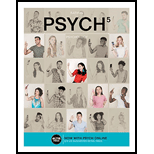
Introduction
Life changes can be either positive or negative, minor or significant, and sometimes making such a transition can prove extremely difficult. Making such a life change, even if positive, can be a very challenging endeavor. However, without making modifications to your practices and behaviors when endeavoring a new transition, this type of alteration to your life ends up becoming more stressful.
Explanation of Solution
Correct answer and explanation
The best answer is (B), in which positive life changes can still prove stressful due to adjustment being required. Making a major life change, even a positive one, is by no means an easy task. Such a change can take us away from people and places we have known virtually all of our lives. Even if the reason for making the life change was beneficial and positive in some respect, it can still be a difficult move to make. However, without adjusting to the new situation, even positive life changes can still be stressful.
Explanation for incorrect statements
Option (A) refers to loneliness. However, loneliness describes a feeling of sadness due to increased isolation from others, which can actually do more to compound one's stress. So, option (a) is incorrect.
Option (C) refers to depression. However, depression describes an emotional state containing severe despondency and dejection, which would only exacerbate feelings of stress. So, option (c) is incorrect.
Option (D) refers to none of the above. However, research shows that without adjusting to a new situation, making a life change can prove especially more stressful. So, option (d) is incorrect.
Therefore, the options (A), (C), and (D) are incorrect.
Want to see more full solutions like this?
Chapter 11 Solutions
PSYCH 5, Introductory Psychology, 5th Edition (New, Engaging Titles from 4LTR Press)
- Match each type of quasi-experimental design to the correct description; Please Explain your answers thoroughlyA. Between-subjects ex post factoB. between-subjects non-equivalent groupsC. within-subjects pre-postD. within-subjects multiple conditions ---29. _____ This design involves researchers using intact groups that are thought to be similar,without random assignment, wherein existing groups receive different levels of the IV.30. _____ This design involves researchers using intact groups, without random assignment,wherein existing groups are the levels of the IV.31. _____ This design involves researchers using one group of participants that serve as theirown control. The participants are tested, receive the intervention, and are tested again. ( OX O ).32. _____ This design involves researchers using one group of participants that serve as theirown control. The participants are exposed to treatment 1, are tested, are exposed totreatment 2, and are tested a second time. ( X1 O X2 O…arrow_forwardWhat does the “social brain” allow us to determine?arrow_forwardWhen does grey matter volume peek for humans?arrow_forward
- What brain region “changes most dramatically” during adolescence?arrow_forwardWhich of the following is an example of nominal data? explain why? and what would the other examples be of datas (ordinal, etc...)a. Ratings of movie enjoymenton a 5-point scale.b. Blood type (A, B, AB, O)c. Height in centimetersd. Temperature in Celsiusarrow_forward• Name two early adulthood developmental tasks • Discuss the developmental tasks of early adulthood. • Differentiate between biological and social ageing.arrow_forward
- Instructions: Dance: Lebanese Dabke Embodiment and Identity: In 150 words or more, reflect on how embodiment, which refers to the physical experience of the body, influences the expression of identities in the chosen dance form. Consider the following questions: How does the body serve as a means of expressing cultural, gender, or personal identities in this dance form? What specific movements, gestures, or techniques contribute to the embodiment of different identities within the dance? Are there any historical or cultural contexts that shape the way identities are expressed through this dance form?arrow_forwardA researcher compares the effectiveness of two forms of psychotherapy for social phobia using an independent-samples t-test. Explain what it would mean for the researcher to commit a Type I error. Explain what it would mean for the researcher to commit a Type II error.arrow_forwardHelllo , according to this topic:Differential Reinforcement, DRA, Create a theise statement?arrow_forward
- Hhow can social media can facilitate bullying and harassment, which can have severe emotional and psychological consequences for victims.arrow_forwardhow do social media platforms often dictate trends in fashion, music, and lifestyle, significantly shaping consumer behavior.arrow_forwardCan users often present idealized versions of themselves, which can lead to unrealistic comparisons and impact self-esteem?arrow_forward
 Ciccarelli: Psychology_5 (5th Edition)PsychologyISBN:9780134477961Author:Saundra K. Ciccarelli, J. Noland WhitePublisher:PEARSON
Ciccarelli: Psychology_5 (5th Edition)PsychologyISBN:9780134477961Author:Saundra K. Ciccarelli, J. Noland WhitePublisher:PEARSON Cognitive PsychologyPsychologyISBN:9781337408271Author:Goldstein, E. Bruce.Publisher:Cengage Learning,
Cognitive PsychologyPsychologyISBN:9781337408271Author:Goldstein, E. Bruce.Publisher:Cengage Learning, Introduction to Psychology: Gateways to Mind and ...PsychologyISBN:9781337565691Author:Dennis Coon, John O. Mitterer, Tanya S. MartiniPublisher:Cengage Learning
Introduction to Psychology: Gateways to Mind and ...PsychologyISBN:9781337565691Author:Dennis Coon, John O. Mitterer, Tanya S. MartiniPublisher:Cengage Learning Psychology in Your Life (Second Edition)PsychologyISBN:9780393265156Author:Sarah Grison, Michael GazzanigaPublisher:W. W. Norton & Company
Psychology in Your Life (Second Edition)PsychologyISBN:9780393265156Author:Sarah Grison, Michael GazzanigaPublisher:W. W. Norton & Company Cognitive Psychology: Connecting Mind, Research a...PsychologyISBN:9781285763880Author:E. Bruce GoldsteinPublisher:Cengage Learning
Cognitive Psychology: Connecting Mind, Research a...PsychologyISBN:9781285763880Author:E. Bruce GoldsteinPublisher:Cengage Learning Theories of Personality (MindTap Course List)PsychologyISBN:9781305652958Author:Duane P. Schultz, Sydney Ellen SchultzPublisher:Cengage Learning
Theories of Personality (MindTap Course List)PsychologyISBN:9781305652958Author:Duane P. Schultz, Sydney Ellen SchultzPublisher:Cengage Learning





